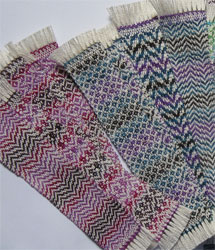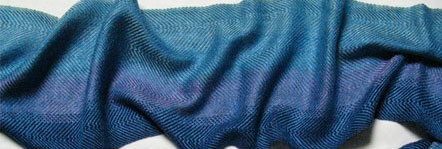I had an aha moment while I was weaving yesterday afternoon.
I’ve been double beating my baby wraps. And this on the Macomber, which has a relatively heavy beater bar — much heavier than on my little counterbalance loom. Double beating definitely slows down the process, but I couldn’t manage to get the wraps to be balanced – the same number of threads per inch in the warp and picks per inch in the weft – without double beating.
But why did I have to double beat? My aha was that it actually makes sense. The wider the weaving, the harder it is to beat; the narrower the easier.
When I make my bookmarks – about 1.5″ wide – I have to set the warp threads closer together and still beat quite lightly to make them look right.

When I’m weaving a scarf – usually about 9″ wide – I usually beat sort of lightly, since I’m usually using fine threads.

When I’m weaving a baby wrap – 31″ wide – I have to beat hard to get the weft right. For me, it’s easier on my body, my brain, and my loom to double beat instead of really beating the heck out of a single beat.
In fact, I realize now that’s why my snowflakes don’t look like snowflakes – I was purposely not double beating. Since I wasn’t making it a special order for anyone, I wanted to see if I could save the time of double beating. Obviously not if I want my woven motifs to work out.
At least now I know. And I know that for me, double-beating makes sense and is worth the extra time it takes.


Sometimes the speed of the beat is more important than the force or using a double beat. You might try flicking your wrists just before the reed hits the cloth to increase the speed of the beat.
The scarf is beautiful – and the bookmarks too!
Best wishes.
Thanks, Stephanie. I appreciate your idea. I’ll see if that works for me without causing any wrist pain.